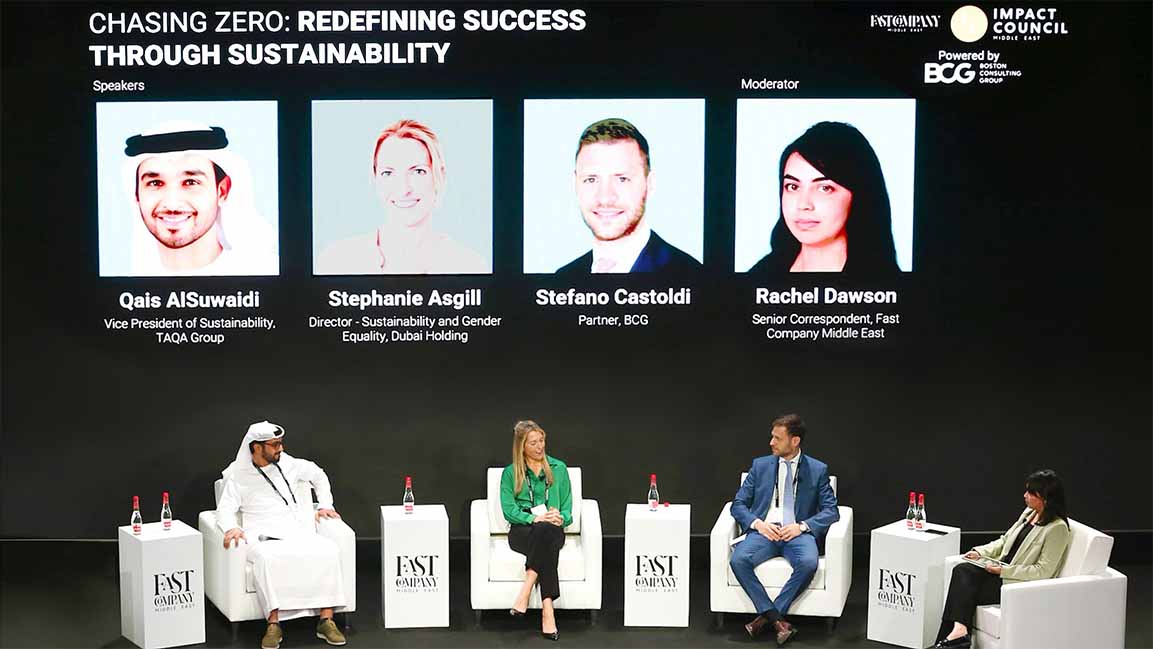- | 10:00 am
How can business leaders in the Middle East balance profitability and long-term sustainability?
Leadership, clear business articulation, and robust monitoring ensure organizations uphold sustainability commitments.

As industries and enterprises unite with a common mission to combat climate change, embracing sustainability is not just a buzzword but a tangible cornerstone of their values.
Amid changes in the global economy and the urgent call for environmental responsibility, The Green Goals Summit sparked discussions guiding us toward a future where we produce no more carbon emissions than we can remove. Industries and enterprises are joining forces with a common goal, making sustainability more than just a trendy term but a practical foundation of their principles
In their panel discussion titled “Chasing zero: Redefining success through sustainability,” industry leaders delve into navigating the challenges of climate change, exploring the intricate balance between profitability and sustainability and holding organizations accountable for their commitments.
ORGANIZATIONAL ADVANCEMENTS AND CHALLENGES
BCG Partner Stefano Castoldi highlights the strides organizations are making in sustainability. He notes that around 2,000 companies worldwide have already pledged to SBTI targets, with an additional 2,000 set to join soon.
Stephanie Asgill, the Sustainability and Gender Equality Director at Dubai Holding, notes the progress in the UAE. She mentions, “Around 150 countries, including the UAE, now enforce ESG disclosure regulations. Moreover, about 130 companies have pledged to the Ministry of Climate Change and Environment’s Climate Responsible Companies initiative.”
However, Asgill provides a crucial perspective. Despite the commitment of 2,000 companies to SBTI targets, only 20 are based in the UAE. This disparity highlights the considerable distance yet to be covered in this domain.
Despite recognizing the progress, Castoldi remains aware of the obstacles ahead. “Three to five trillion dollars per year have to be invested in the next 20 to 30 years to meet net-zero ambitions, which is a huge challenge,” he says.
Castoldi emphasizes the significance of these companies reducing their emissions at a net-zero cost. He suggests that approximately 20 to 30% of their emissions can be mitigated without incurring extra expenses. This can be accomplished through initial energy efficiency initiatives, paving the way for funding future endeavors in this direction.
Asgill echoes concerns about the balance between financial performance and long-term sustainability. Referencing a CEO’s perspective, she articulates, “I cannot afford to go green if it means taking me into the red.”
Additionally, she emphasizes challenges related to reporting and disclosures. While more UAE organizations commit to integrating sustainability, they must submit their targets and plans for achieving them and undergo verification.
Vice President of Sustainability at TAQA Group, Qais AlSuwaidi, stresses that sustainability involves a holistic approach. This entails reducing emissions, optimizing resource use, enhancing workforce dynamics, and focusing on the social aspects of their ESG strategy. It includes commitments to corporate social responsibility (CSR), diversity and inclusion, and health and safety standards, which are equally crucial alongside governance measures.
Discussing TAQA’s headway, AlSuwaidi highlights the company’s collaboration with ADNOC Distribution for electric vehicle charging stations. Additionally, he mentions TAQA’s ambitious goal of reducing emissions by 25% by 2030.
THE NEED FOR BUSINESS CASE ARTICULATION
Asgill highlights the importance of business cases, emphasizing their significance in implementing efficiency measures. “I honestly believe that if we can’t demonstrate the business case, we will not move from the commitments that we’re making and the ambitions into true action, so it’s critical,” she asserts.
Regarding developing a business case and strategy, Castoldi stresses the necessity of a well-defined roadmap with clear actions and timelines. “Getting into a business case presumes that you have a clear road map ahead of you with clear actions that you need to develop with a certain time frame and owner. I think most of the companies are not yet there. So I think you need to be extremely structured in your approach, set up this clear strategy and road map with clear steps,” he adds.
Asgill also recommends incorporating energy efficiency measures into an organization’s business planning and strategy. She references a U.S. study that indicates commercial buildings implementing such measures can cut utility costs by approximately 30%.
HOLDING ORGANIZATIONS ACCOUNTABLE
AlSuwaidi emphasizes that leadership commitment, transparency, disclosure, and reporting are crucial for holding organizations accountable for their promises.
Castoldi echoes a comparable viewpoint, emphasizing the importance for organizations to construct their abatement curves from the present until 2050. “This is pivotal for establishing accountabilities within the organization, ideally with leadership support, as it requires considerable effort and may encounter resistance.”
Asgill concludes the conversation by emphasizing the significance of raising awareness to prompt a shift in public attitudes and behaviors. She references her organization’s initiatives, notably their establishment of a news network.
“It’s to engage members of the public on these critical topics, to try and raise awareness and say ‘you as a consumer, here are the choices that you have, and here’s why those choices are important.’”








































